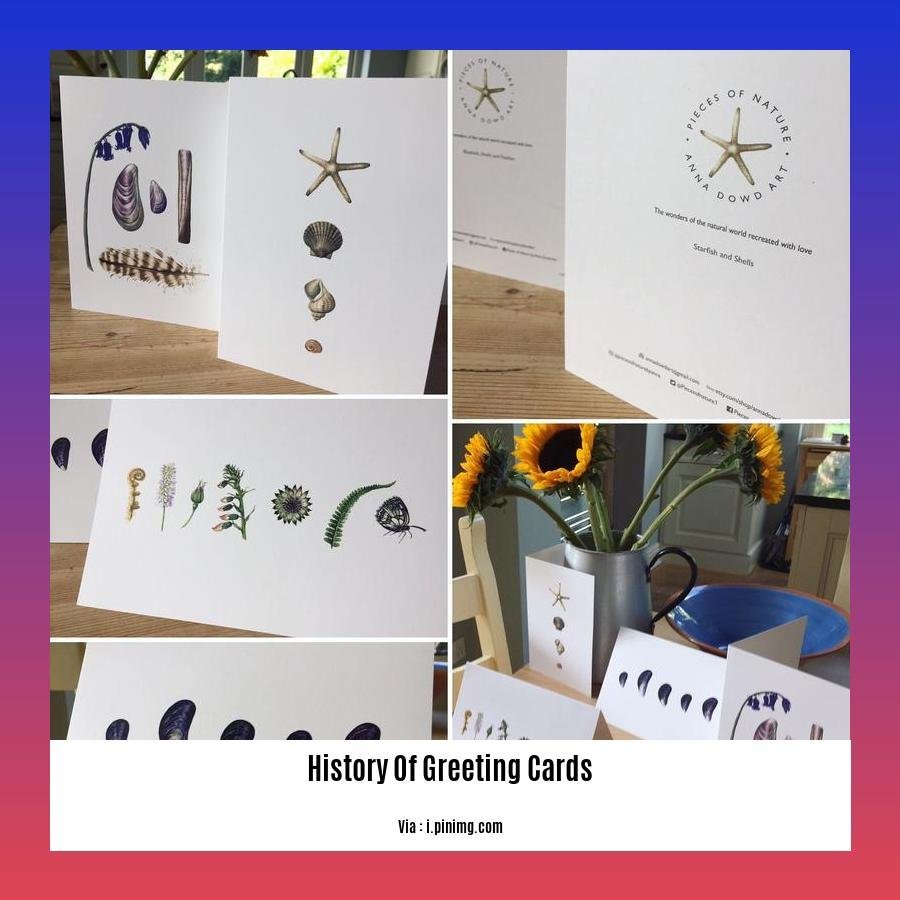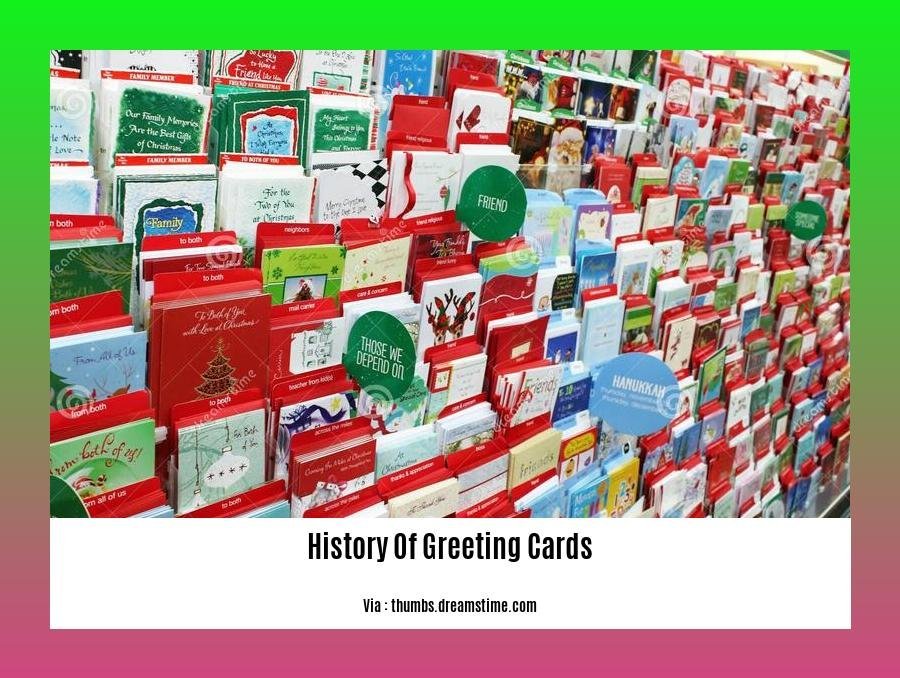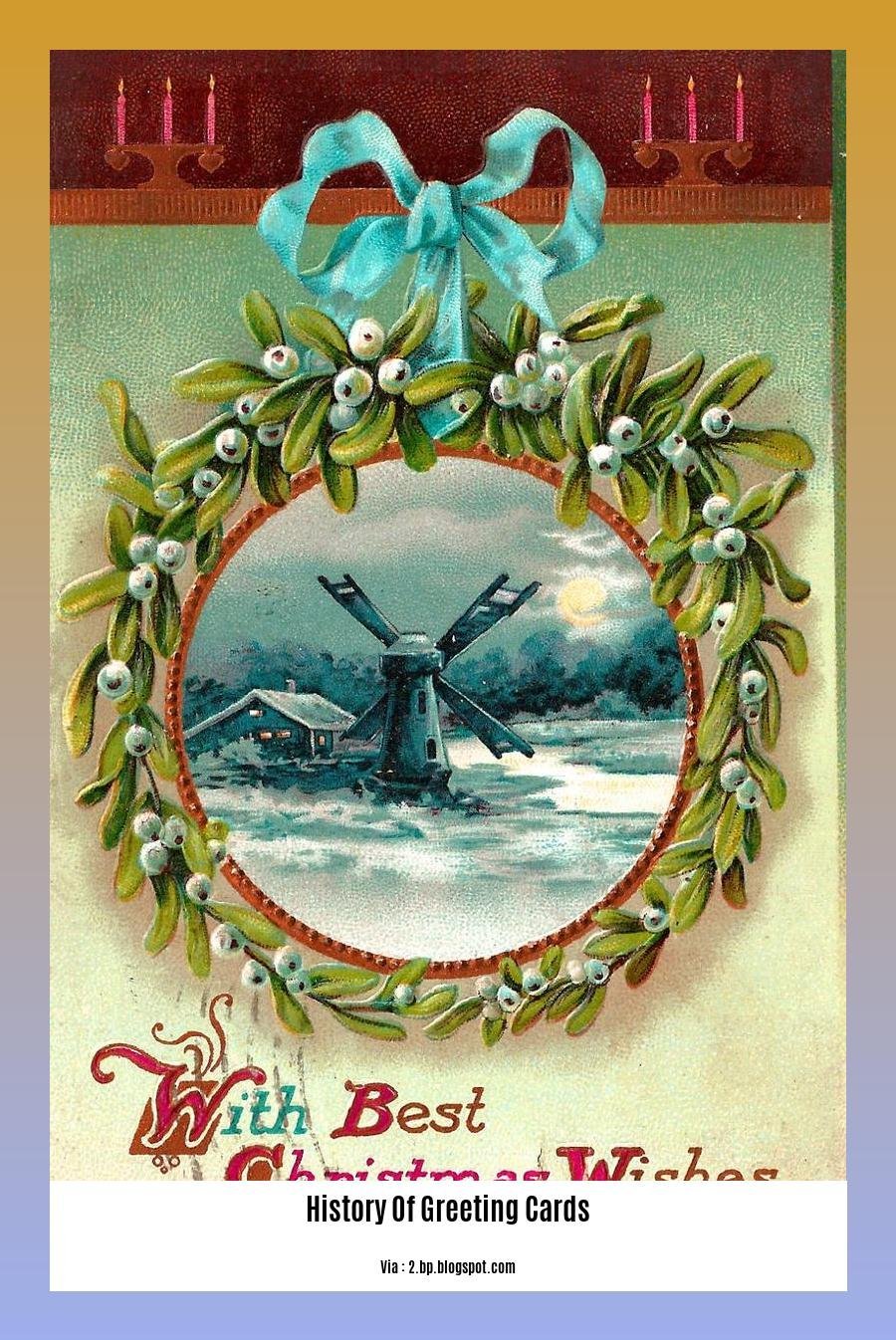Step into the enchanting world of greeting cards, where history, emotions, and artistry intertwine. Join us on “A Journey Through Time: Uncovering the History of Greeting Cards,” as we explore the remarkable evolution of these treasured tokens of affection. From their modest origins to their transformation into emblems of love, gratitude, and cheer, prepare to be captivated by the stories, people, and innovations that have shaped the colorful landscape of greeting cards.
Key Takeaways:
- Ancient China marked the beginning of greeting cards, where people exchanged well wishes notes during the New Year celebrations.
- Egyptians utilized papyrus scrolls as a means of sending greetings.
- Handmade paper greeting cards emerged in Europe by the early 15th century, showcasing intricate craftsmanship.
- The year 1860 witnessed the commencement of commercial production of greeting cards, facilitating mass distribution.
History of Greeting Cards

Greeting cards, those cherished tokens of affection and sentiment, have a fascinating history that spans centuries. Embark on a captivating journey through time as we unveil the intriguing stories behind these humble expressions of goodwill.
The Seeds of Sentiment: Ancient Origins
Before technology and mass production, the tradition of greeting cards had its roots in ancient civilizations. In China, the seeds of sentiment were sown during the New Year when people exchanged messages of goodwill.
Early Egyptians expressed their greetings on papyrus scrolls, a testament to the enduring power of the written word.
The Blossoming of Cards: Handmade Delights
By the early 15th century, the art of greeting cards flourished in Europe. Artisans crafted intricate handmade paper cards, each one a unique work of art. These cards were often adorned with intricate designs, reflecting the creativity and skill of their makers.
The Dawn of Mass Production: A Revolution in Greetings
The industrial revolution ushered in an era of mass production, and greeting cards were no exception. The 1860s marked a turning point as the first mass-produced cards rolled off the assembly lines.
The accessibility and affordability of these cards led to their widespread popularity, and they quickly became a staple of celebrations and expressions of sympathy.
The Evolution of Designs: Reflecting the Times
Over the years, greeting cards have evolved in design, mirroring the changing tastes and trends of society. From Victorian-era elegance to the vibrant colors of the psychedelic sixties, cards have captured the spirit of each era.
With the advent of digital technology, e-cards emerged, offering a modern twist on the traditional format. While they lack the tangible charm of physical cards, e-cards have their own appeal, reaching across vast distances with the click of a button.
Throughout history, greeting cards have played a significant role in connecting people and conveying emotions. Whether it’s a birthday wish, a heartfelt thank you, or an expression of sympathy, these cards have become an integral part of our lives.
Did you know about the history of gloves? Discover how this versatile accessory has transformed through the ages.
Explore the fascinating history of golf carts and witness how this humble invention revolutionized the sport of golf.
Unravel the intriguing history of gym shoes and learn how these iconic footwear evolved from simple canvas slippers to high-tech performance gear.
Rise of the Hallmark Company: The story of Hallmark, one of the most iconic greeting card companies, and its impact on the industry.

It’s a story of innovation, creativity, and the power of sentiment that has captured the hearts and imaginations of people worldwide. Let’s embark on a journey to discover the fascinating rise of the Hallmark Company, one of the most iconic greeting card companies in history.
Hallmark’s Humble Beginnings
In the early 1900s, a young man named Joyce C. Hall, hailing from the heartland of Nebraska, found himself drawn to the world of greeting cards. Inspired by the joy and connection that these small tokens of affection could bring, he set out on a mission to create his greeting card company.
From Postcards to Greeting Cards
Starting with a modest venture selling postcards, Joyce Hall displayed an unwavering belief in the potential of greeting cards to touch lives. As his business flourished, he expanded his offerings to include greeting cards, recognizing their ability to convey emotions and sentiments more effectively than mere postcards.
The Hallmark Brand: A Legacy Unfolds
In 1928, a pivotal moment arrived – the birth of the Hallmark brand name. This strategic move marked the beginning of a legacy that would transform the greeting card industry. Hallmark cards became synonymous with quality, creativity, and a touch of personal expression, making them a cherished part of countless celebrations and expressions of sympathy.
Shoebox Greetings: A Touch of Humor
The 1960s witnessed the rise of Hallmark’s Shoebox Greetings line, a stroke of genius that brought a touch of humor and lightheartedness to the world of greeting cards. These witty and often irreverent cards struck a chord with audiences, becoming a runaway success and further solidifying Hallmark’s position as an industry leader.
Expressions From Hallmark: A Journey of Sentiment
As the years went by, Hallmark continued to innovate and adapt to the evolving needs of its customers. The 1980s saw the introduction of the Expressions From Hallmark greeting card brand, which delved deeper into the realm of personal and sentimental messages. These cards captured the nuances of human emotions, making them ideal for expressing heartfelt sentiments during life’s most significant moments.
Hallmark’s Enduring Legacy
Over a century after its inception, Hallmark stands as the undisputed leader in the greeting card industry. With its unwavering commitment to quality, innovation, and emotional connection, the company has had a profound impact on the way people communicate their feelings, bringing joy, comfort, and a touch of magic to countless lives around the globe.
Key Takeaways:
-
Hallmark’s journey began with Joyce C. Hall’s passion for greeting cards, transforming a simple idea into a global empire.
-
The company’s transition from postcards to greeting cards marked a strategic shift towards capturing the power of emotional expression.
-
The introduction of the Hallmark brand in 1928 cemented the company’s reputation for quality and creativity, making it a household name.
-
Shoebox Greetings revolutionized the industry with its humorous and lighthearted approach, expanding Hallmark’s reach and appeal.
-
Expressions From Hallmark delved into the realm of personal and sentimental messages, catering to the evolving needs of customers.
-
Hallmark’s enduring legacy lies in its ability to consistently innovate and adapt, staying true to its mission of connecting people through heartfelt sentiments.
Citations:
– Hallmark Corporate History
– Country Living: The History of Hallmark Cards
Technological Advancements and Changing Trends: The impact of advancements like printing technology and the internet on the greeting card industry, including the rise of e-cards and digital greetings.
Throughout history, greeting cards have witnessed a remarkable transformation, profoundly influenced by advancements in printing technology and the advent of the internet. These innovations have not only revolutionized the way greeting cards are produced and distributed but have also given rise to new formats, designs, and trends.
The Printing Revolution
The development of the printing press in the 15th century marked a pivotal moment in the history of greeting cards. Before that, cards were predominantly handwritten or painstakingly crafted by artisans. The printing press enabled the mass production of cards, making them more affordable and accessible to the general public.
Digital Transformation
The advent of the internet in the late 20th century ushered in a new era for greeting cards. With the rise of e-cards and digital greetings, people could now send personalized messages electronically, transcending geographical boundaries and eliminating the need for physical cards. Digital greetings also introduced interactive elements, such as animations, music, and videos, offering a more immersive and engaging experience.
The Rise of E-Cards
E-cards, or electronic greeting cards, have become increasingly popular in recent years, offering several advantages over traditional cards. They are convenient, environmentally friendly, and cost-effective. E-cards also provide a wider range of designs and customization options, allowing users to create unique and personalized greetings.
Impact on the Greeting Card Industry
These technological advancements have significantly impacted the greeting card industry. While the demand for traditional paper cards has declined, the rise of e-cards has opened up new market opportunities for greeting card companies. Many traditional card manufacturers have adapted to the changing landscape by offering both physical and digital cards, catering to the preferences of a diverse customer base.
Key Takeaways:
-
Printing technology revolutionized the greeting card industry by enabling mass production, making cards more affordable and accessible.
-
The internet brought about a new era of digital greetings, offering convenience, personalization, and interactive elements.
-
E-cards have gained popularity due to their convenience, eco-friendliness, and cost-effectiveness.
-
Traditional card manufacturers have adapted to the changing landscape by offering both physical and digital cards, catering to a diverse customer base.
-
Technological advancements have not only transformed the production and distribution of greeting cards but have also influenced their designs and trends.
Citations:
- History of the Greeting Card
- How the Internet Changed the Greeting Card Industry
Cultural and Social Significance: The cultural and social significance of greeting cards, their role in expressing emotions, celebrating occasions, and fostering connections.
Greeting cards, those colorful and heartfelt tokens of affection, have a rich history that spans centuries. Their evolution mirrors the changing social and cultural landscape, reflecting our deepest emotions and connecting us across vast distances.
A Canvas for Expressing Emotions:
Greeting cards are an expressive medium, a canvas upon which we paint our sentiments with words and images. They offer a tangible way to convey joy, love, sympathy, and gratitude, bridging the gap between hearts and souls.
Celebrating Life’s Milestones:
From birthdays to anniversaries, graduations to retirements, greeting cards have become an integral part of celebrating life’s milestones. They serve as treasured keepsakes, capturing precious moments in time and reminding us of the people who care.
Fostering Connections Across Miles:
In a world where distance often separates us, greeting cards act as messengers of love and connection. They bridge the physical gaps, carrying our thoughts and feelings to those we hold dear, fostering a sense of closeness and belonging.
A Reflection of Cultural Values:
Greeting cards are a reflection of the values, traditions, and beliefs of the cultures they represent. They depict iconic symbols, folklore, and customs, providing a glimpse into the soul of a nation or community.
Key Takeaways:
-
Greeting cards are a powerful medium for expressing emotions and conveying heartfelt messages.
-
They play a significant role in celebrating life’s milestones, marking special occasions with tangible mementos.
-
Greeting cards serve as a bridge across distances, fostering connections and a sense of belonging among loved ones.
-
They reflect the cultural values, traditions, and beliefs of the societies they represent, providing insights into diverse customs and perspectives.
-
Greeting cards have evolved from simple handwritten notes to intricately designed mass-produced cards, reflecting changing artistic styles and societal trends.
Sources:
[1] Packaged Sentiments: The Social Meanings of Greeting Cards
[
[2] Greeting Cards as a Social Connector: Psychology of Card Giving and Receiving
[
FAQ
Q1: When did the tradition of sending greeting cards begin?
A1: The tradition originated in ancient China, where people exchanged messages of goodwill during the New Year.
Q2: What materials were used for early greeting cards?
A2: Early Egyptians sent greetings on papyrus scrolls, while in Europe, handmade paper greeting cards were being exchanged by the early 15th century.
Q3: When did the commercial production of greeting cards begin?
A3: The production of greeting cards in commercial quantities commenced in 1860.
Q4: What was the significance of the Hallmark brand?
A4: In 1928, Hallmark introduced its brand name and began printing it on the back of every greeting card, solidifying its position within the industry.
Q4: How did Hallmark continue to innovate in the greeting card industry?
A4: In the 1960s, Hallmark launched the successful Shoebox Greetings line of humorous greeting cards, followed by the Expressions From Hallmark brand in the 1980s, featuring more personalized and sentimental messages.
- Unveiling the Enigma: Mansoureh Khojasteh Bagherzadeh’s Public Appearances & Private Life in Iran - July 18, 2025
- Unveiling the Mystery: Mansoureh Khojasteh Bagherzadeh’s Husband: A Rare Glimpse into a Private Life - July 18, 2025
- Unveiling Masoud Khamenei’s Mother: Power, Influence, and Iran’s Future - July 18, 2025
















